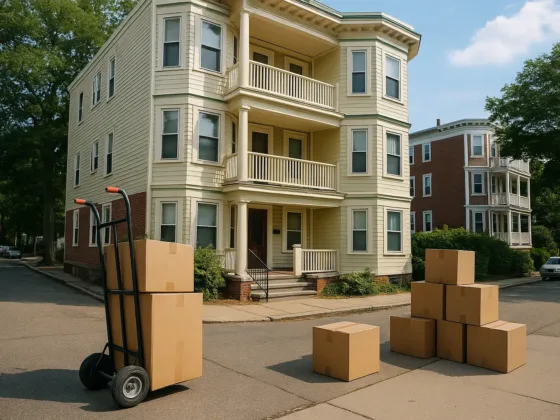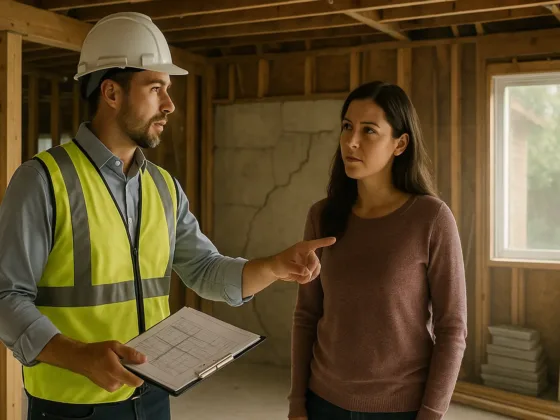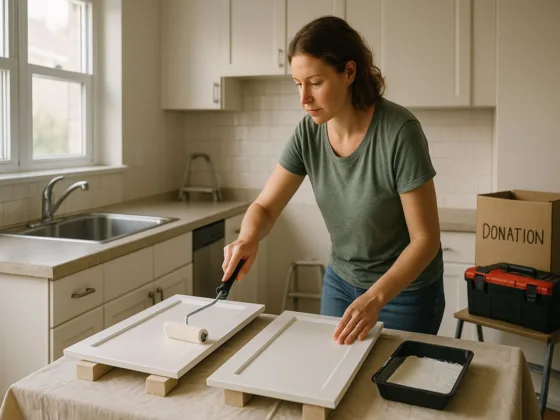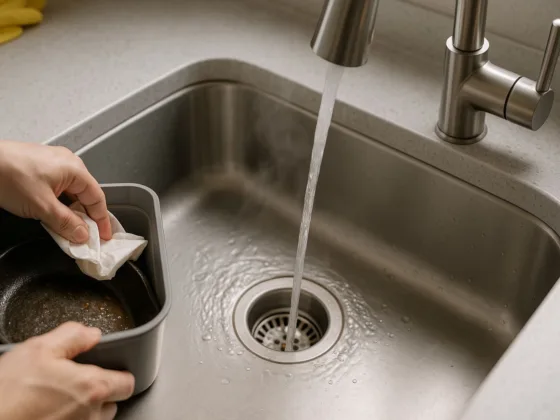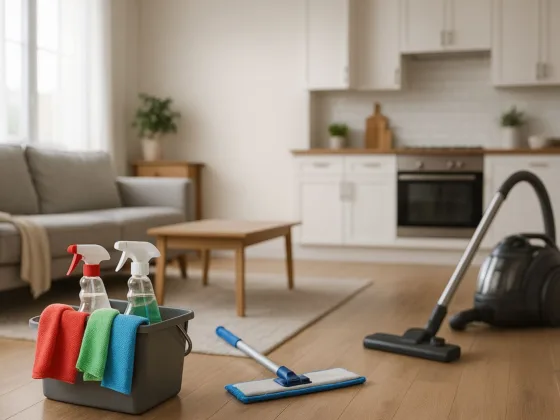Table of Contents Show
Quick Answer: The fastest way to upgrade a commercial building without blowing the budget is to focus on high-impact essentials: LED lighting and smart controls, HVAC and ventilation improvements, curb appeal and entrances, lobbies and shared spaces, restrooms and cloakrooms, and basic safety and maintenance repairs. Start with a quick walkthrough and energy benchmark, then tackle upgrades in phases so you can keep the building open while you improve comfort, cut energy costs, and boost long-term property value.
Commercial buildings age quietly. One year you only notice a few scuffed walls and buzzing light fixtures; the next, your lobby feels stuck in 2008, your energy bills are painful, and tenants are asking when you’re going to “modernize the place.”
This guide is for owners, property managers, and facility teams who want practical, budget-aware ways to upgrade an existing commercial building — offices, small retail plazas, mixed-use properties, medical and professional buildings — without emptying the entire building or starting from scratch.
The good news? You usually don’t need a full gut renovation to make a commercial property feel fresh, efficient, and competitive again. A handful of well-planned, relatively simple upgrades can make the building look better, perform better, and command higher rents — without shutting everything down for months.
Below we’ll walk through six practical upgrade ideas you can apply to almost any commercial building. We’ll keep the focus on:
- Changes that tenants and customers actually notice
- Energy savings and comfort improvements that show up on your utility bills
- Upgrades you can phase in to minimize downtime
- Where it makes sense to bring in qualified pros for design, HVAC, or compliance work
Important: Building codes, accessibility rules (such as ADA-type requirements), fire regulations, and permitting vary by location. Treat this guide as a starting point, and always confirm details with local authorities and licensed professionals before you change anything structural or mechanical.
Before You Start: Walk the Building and Make a Shortlist
Before you spend a dollar, take a structured walk through the property with a simple checklist. Look at the building the way a new tenant, customer, or buyer would:
- Exterior and parking: Is the facade clean and well-painted? Is the parking lot safe, well-lit, and clearly striped?
- Entrances and lobby: Do people instantly know where to go? Does the entry feel bright, secure, and welcoming?
- Lighting and comfort: Are there dark corners, flickering fixtures, hot/cold spots, or stale air?
- Restrooms and cloakrooms: Do they look dated, cramped, or slightly “tired” even if technically clean?
- Safety basics: Any loose handrails, trip hazards, worn flooring, slamming doors, or outdated emergency lighting?
For many owners, the first real “wake-up call” comes when they benchmark their energy use against similar buildings using tools like the EPA’s free ENERGY STAR® Portfolio Manager®, which lets you compare your building’s performance to similar properties. Utility providers and energy-efficiency programs often offer reports that show how much you can save with simple lighting, HVAC, and envelope upgrades.
As you walk, jot down everything you notice. Then group issues into three buckets: life safety and code items, comfort and appearance, and future nice-to-haves. The ideas below will help you turn that checklist into a realistic commercial building upgrade plan.
1. Upgrade Lighting and Controls for Instant Impact
If you only do one project this year, make it lighting. Swapping old fluorescent or halogen fixtures for modern LEDs and adding basic controls can deliver:
- Much lower electricity use than traditional bulbs
- Far longer lamp life (less ladder time and maintenance)
- Less unwanted heat in the space, which also helps your cooling load
In many commercial buildings, lighting is the easiest “win” because it’s visible, relatively non-disruptive to install, and often eligible for rebates or tax incentives through local utilities and energy-efficiency programs.
Smart lighting moves that pay off
- Switch to LED fixtures and lamps: Focus on high-traffic areas first: lobbies, corridors, stairwells, restrooms, parking areas, and exterior signage.
- Add occupancy and daylight sensors: Stairwells, storage rooms, meeting rooms, and back-of-house spaces are perfect for lights that only run when they’re actually needed.
- Layer the light: In lobbies and offices, combine ambient lighting with task lighting and accent lighting to make spaces both functional and attractive.
- Standardize color temperature: Use warm-neutral tones in hospitality or retail, and neutral-cool tones for offices so the entire building feels intentional instead of “patched together.”
Mini example: In a tired 1980s office building, the owner replaced buzzing troffers in corridors and the lobby with LED panels, added simple occupancy sensors in back-of-house spaces, and upgraded exterior wall packs in the parking lot. Tenants instantly commented on the brighter, safer feel — and the owner saw a drop in the electricity bill without touching the rest of the building.
If your lighting system is very old, this is also a great time to have an electrician evaluate your panels, emergency lighting, and egress signage so everything stays code-compliant while you modernize.
When you’re ready to refresh the exterior after lighting upgrades, you can dive deeper into color choices and coatings in The Art and Science of Painting Commercial Buildings: Elevating Your Brand’s Image for more details on commercial painting strategy.
2. Improve Comfort with Smarter HVAC and Better Air
Comfort is a big reason tenants stay or go. If the building regularly feels too hot, too cold, or stuffy, many of your other upgrades will fall flat — even if the space looks brand new.
Start with a basic HVAC and ventilation health check
- Service existing equipment: Make sure filters are changed on schedule, dampers and actuators are working, and thermostats actually match the zones they control.
- Balance airflows: Unbalanced systems create hot/cold spots and complaints. A basic test and balance can dramatically improve perceived comfort.
- Upgrade to smart thermostats or controls: Even simple scheduling and occupancy-based control can trim energy use without sacrificing comfort.
Especially since the pandemic, many tenants are asking specific questions about ventilation and indoor air quality. Modern guidance often points to:
- Increasing outdoor air and filtration (with higher MERV-rated filters, if compatible with your equipment)
- Aiming for higher air changes per hour (ACH) in occupied areas compared to older recommendations
- Being more deliberate about ventilation in meeting rooms, training rooms, and other high-occupancy spaces
For more technical detail, building owners often refer to documents like the EPA’s “Building Air Quality” guide for building owners and facility managers and the CDC’s guidance on ventilation in buildings, which explain how ventilation, filtration, and air changes contribute to healthier indoor environments.
Mini example: A small medical office building upgraded to smart thermostats and increased filtration levels during a scheduled HVAC service. The owner didn’t replace the entire system, but tenant surveys showed fewer complaints about stuffy rooms and more confidence in the building’s air quality.
Don’t DIY everything: For major system changes, code compliance, or complex buildings, work with a licensed HVAC contractor who understands commercial loads, controls, and local code requirements. For more on why credentials matter, review Reasons to Hire a Professional Licensed HVAC Contractor.
3. Refresh the Exterior, Entrance, and Curb Appeal
Tenants may sign a lease for square footage and price, but they judge the building on what they see from the street and at the front door. A tired or confusing exterior quietly drags down perceived value and can even make a great interior feel “cheap.”
High-ROI exterior upgrade ideas
- Repaint or re-finish the facade: Fresh paint, updated trim colors, and clean metalwork can make even older stock look contemporary again.
- Update signage: Consider modern, well-lit signage that’s easy to read at a distance and at night.
- Upgrade the entry sequence: Clean glass, modern door hardware, clear wayfinding, and simple landscaping make arriving feel easy instead of stressful.
- Fix the parking lot: Repair potholes, refresh striping, add accessible spaces where needed, and ensure lighting feels safe and welcoming.
- Add greenery: A few well-chosen trees, planters, and low-maintenance landscaping can soften hard edges and align your building with “green” expectations.
Mini example: A small retail strip with faded paint, flickering sign lighting, and cracked parking-lot lines felt half empty even when tenants were doing well. The owner invested in new facade paint, LED signage lighting, re-striped parking, and a few hardy trees near the main entrance. Within a year, one tenant expanded their space, and another renewed a lease at a higher rate because the center felt safer and more modern.
If you want to explore how exterior design affects perceived value and tenant attraction, you can also read Why Your Property Should Have a Good Exterior Design, which goes deeper into curb appeal and first impressions.
The most successful commercial buildings are designed around people’s actual day-to-day experience, not just square footage. Tenants and visitors remember how a place feels, not just how it looks in a brochure.
When you upgrade lobbies, hallways, and shared spaces, think beyond “new furniture” and ask:
- Where do people naturally pause, meet, or wait?
- Are there clear sightlines and intuitive wayfinding?
- Does the space feel safe, inclusive, and easy to navigate?
Simple interior upgrades that feel high-end
- Clean, durable finishes: Replace tired carpet with durable LVT or tile; repaint walls in a coordinated palette; repair chipped corners and baseboards.
- Better acoustic comfort: Add acoustic ceiling tiles, wall panels, or softer surfaces in noisy reception areas and open-plan offices.
- Biophilic touches: Plants, natural textures, and warm materials can reduce stress and boost perceived quality of the space.
- Flexible furniture: In offices, use modular furniture and moveable partitions to support quiet work, collaboration, and informal meetings.
If you serve office tenants, you can also borrow ideas from modern wellness frameworks that tie building design to occupant health and productivity, such as the WELL Building Standard. Even without formal certification, paying attention to light, air, comfort, and movement can make your building much more attractive to employers and employees.
5. Modernize Restrooms and Cloakrooms (They’re More Important Than You Think)
Restrooms and cloakrooms are small spaces with outsized influence on how “modern” or “cared for” a building feels. Even if the plumbing works, outdated fixtures, dim lighting, and cramped layouts send the wrong message.
High-impact upgrades for restrooms and cloakrooms
- Increase brightness and cleanliness: Use light-colored, easy-clean finishes, modern LED lighting, and high-quality ventilation to keep spaces feeling fresh.
- Update fixtures and accessories: Touchless faucets, efficient toilets and urinals, modern partitions, and quality mirrors all make a big difference.
- Improve privacy and flow: Rethink layouts so users don’t feel cramped; add more hooks, shelves, and surfaces where people can set bags, coats, or laptop cases.
- Upgrade cloakrooms and staff changing areas: These areas are often neglected but are critical in hospitality, education, and workplace settings.
If you’re looking for layout inspiration, dedicated cloakroom specialists can be very helpful. For example, you can explore modern cloakroom layouts, storage solutions, and finishes through resources like Cloakroom Designs by Cloakroom Solutions, which showcase practical ways to maximize space while keeping things tidy and accessible.
Done well, restroom and cloakroom upgrades often generate some of the most enthusiastic tenant feedback — because everyone notices them and uses them every day.
6. Tackle “Unseen” Repairs and Safety Issues
Not all upgrades are glamorous, but tenants and insurers care deeply about basic safety and reliability. Deferred maintenance is one of the fastest paths to complaints, lost leases, and lower valuations.
Key repair areas to review
- Doors and hardware: Fix sagging doors, misaligned closers, and broken hardware that compromise security or accessibility.
- Flooring and trip hazards: Address cracks, loose tiles, worn threshold transitions, and uneven surfaces — especially on stairs and in high-traffic corridors.
- Lighting and emergency systems: Confirm exit signs and emergency lights function during outages; replace or repair damaged fixtures.
- Roof and drainage: Inspect for leaks, ponding water, clogged gutters, and downspouts that can lead to interior damage and mold.
For a deeper dive into the kinds of repairs that quickly improve daily comfort, see Understanding 5 Key Repairs for Commercial Building Comfort, which covers common issues with doors, flooring, lighting, and more.
7. Plan Funding, Rebates, and Phased Work
Finally, smart owners think about how to pay for upgrades and how to phase them so the building stays operational. A simple plan helps you make steady progress instead of reacting to emergencies.
Make a simple 3–5 year upgrade plan
- Benchmark your energy and maintenance costs: Use recent utility bills and basic walk-through notes to identify which systems are costing the most.
- Rank projects by ROI and risk: Put life-safety and code issues at the top, followed by projects with clear payback (lighting, controls, basic insulation, and sealing).
- Investigate incentives: Many regions offer utility rebates, grants, or tax deductions for energy-efficient lighting, HVAC, and envelope upgrades. It’s worth asking your accountant about available energy-efficiency programs in your area.
- Phase work to minimize downtime: Schedule noisy or disruptive work during off-hours, breaks between leases, or quieter seasons for your tenants.
- Communicate clearly with tenants: Give advance notice, share timelines, and explain the benefits (better comfort, lower operating costs, improved safety).
For larger projects — from major HVAC overhauls to envelope improvements — it may also be worth exploring resources like the U.S. Department of Energy’s Better Buildings Solution Center, which shares case studies and practical guidance on energy-efficient commercial upgrades.
Quick Checklist: Simple Commercial Building Upgrades
- [ ] Switch to LED lighting with basic occupancy and daylight controls
- [ ] Service HVAC, improve ventilation, and consider smarter thermostats
- [ ] Refresh the facade, signage, entry, and parking lot appearance
- [ ] Upgrade lobbies and shared spaces around people’s real needs
- [ ] Modernize restrooms and cloakrooms with brighter, more functional layouts
- [ ] Address obvious maintenance and safety issues before they become emergencies
- [ ] Create a simple 3–5 year plan that prioritizes high-ROI, safety-critical work
FAQs About Upgrading a Commercial Building
Start with LED lighting and basic controls, minor paint and finish updates, and simple restroom improvements like new fixtures and brighter lighting. These projects change how the building feels immediately, are usually quick to install, and often qualify for rebates or incentives.
Plan upgrades in phases and work zone by zone. Do noisy or dust-producing work after hours or on weekends, and focus on “circulation” spaces (corridors, lobbies, stairwells) in short, well-communicated bursts. Partnering with experienced commercial contractors who specialize in occupied-building renovations is worth it — they know how to protect finishes, control dust, and keep people moving safely through the site.
In most commercial buildings, the biggest long-term wins come from projects that combine energy savings with occupant comfort: high-efficiency lighting and controls, better HVAC and ventilation, and envelope improvements like sealing, insulation, and high-performance glazing. Exterior and lobby upgrades can also boost valuation and lease rates by making the property more attractive to higher-quality tenants.
A practical approach is to do a quick visual walkthrough every year, a deeper review of building systems every 3–5 years, and a more strategic update of finishes and common areas every 7–10 years. Safety-related issues, code changes, and serious comfort problems should always be addressed as soon as you discover them.
Before you start, confirm local code and permit requirements, review your leases for tenant obligations, and talk to licensed professionals (engineers, architects, and contractors) about structural changes, fire protection, accessibility, and mechanical systems. Getting good advice up front reduces surprises, keeps your project legal, and helps you prioritize the right work.
Further Reading from Trusted Organizations
If you want to go deeper into energy performance, ventilation, and healthy building design, these resources are a useful next step:
- ENERGY STAR® Portfolio Manager® for commercial buildings – benchmark and track energy use across your property portfolio.
- U.S. Department of Energy Better Buildings Solution Center – case studies, best practices, and tools for energy-efficient commercial upgrades.
- EPA “Building Air Quality” guide – practical indoor air quality guidance for building owners and facility managers.
- CDC ventilation and indoor air guidance – key recommendations on airflow, filtration, and air changes in occupied buildings.
- WELL Building Standard – a building rating system focused on health, comfort, and well-being in the built environment.
Perla Irish – Content Manager at Dream Lands Design
Perla writes about home improvement, interiors, and property-related topics for real-world homeowners and building owners. You can see more of her work and credentials on her Perla Irish profile.
Reviewed by
Dream Lands Design Editorial Team
This article has been reviewed against Dream Lands Design’s Mission & Editorial Standards for accuracy, clarity, and practical usefulness to readers. The team regularly updates guides like this to reflect current best practices in commercial building maintenance, comfort, and energy efficiency.
How We Keep This Article Accurate
- We cross-check upgrade recommendations against current guidance from recognized energy, health, and building-performance organizations.
- We encourage readers to consult local professionals for code-specific requirements, structural concerns, and project-specific engineering.
- When standards or incentives change, we aim to update this guide so it stays useful and relevant.
Disclaimer: This article is for general informational purposes only and is not a substitute for professional advice. Always consult qualified engineers, architects, contractors, and local authorities before making structural changes or major mechanical upgrades to any commercial building.



